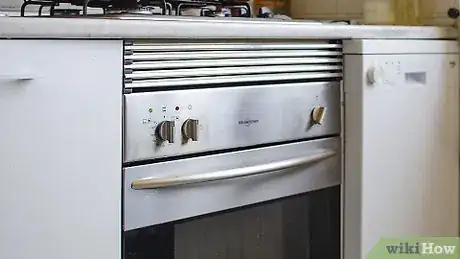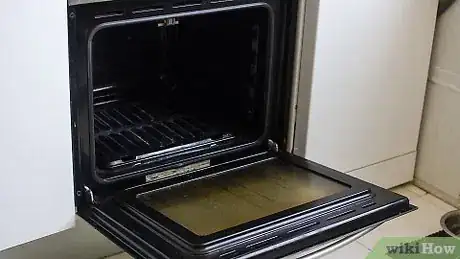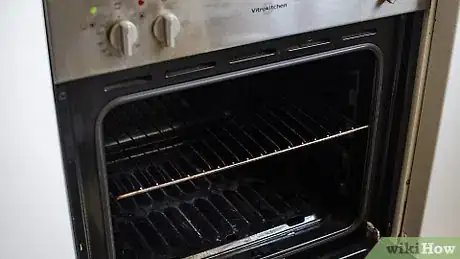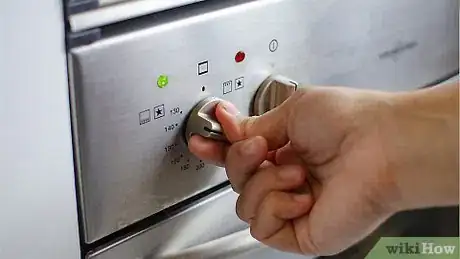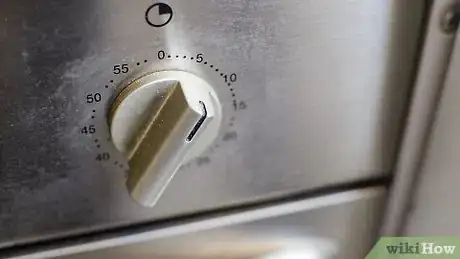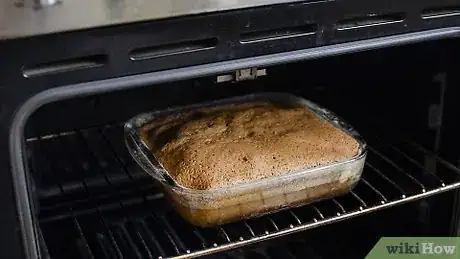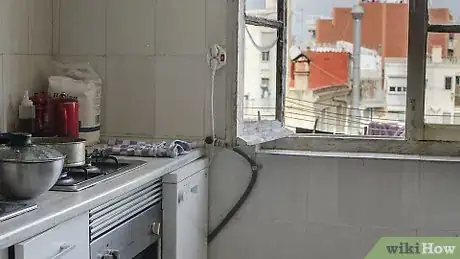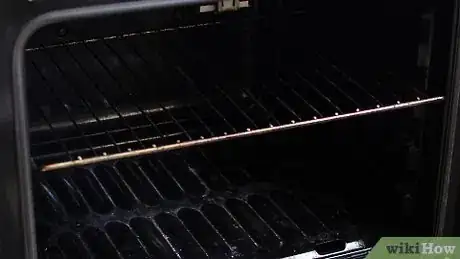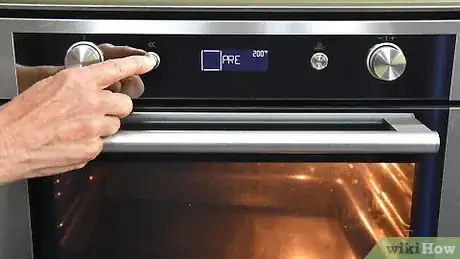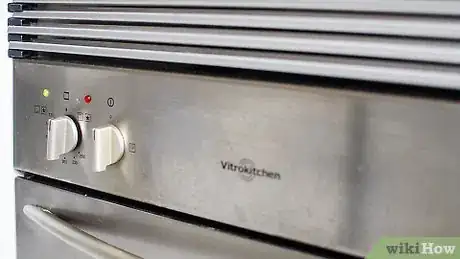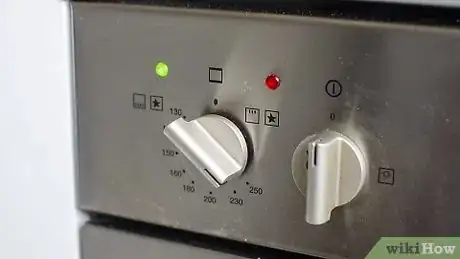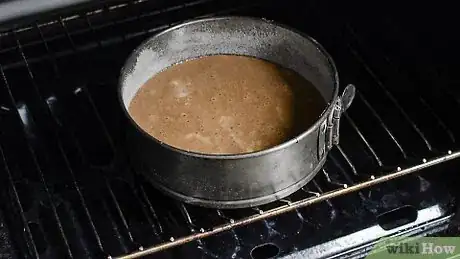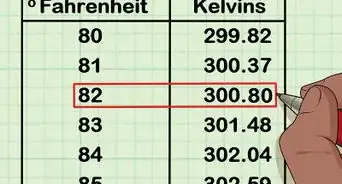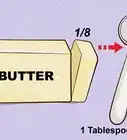wikiHow is a “wiki,” similar to Wikipedia, which means that many of our articles are co-written by multiple authors. To create this article, 42 people, some anonymous, worked to edit and improve it over time.
There are 10 references cited in this article, which can be found at the bottom of the page.
The wikiHow Video Team also followed the article's instructions and verified that they work.
This article has been viewed 1,506,266 times.
Learn more...
Before you bake something, your oven needs to be heated to the proper temperature. While it takes only a few seconds to turn on your oven, it can take several minutes for it to reach the right temperature. The act of turning on your oven and letting it heat up to the right temperature is referred to as "preheating." Because of how long it takes for an oven to warm up, most recipes will recommend that you turn your oven on first, before starting to cook. This article will show you how to preheat both an electrical oven and a gas oven.
Things You Should Know
- Check that you haven't left anything inside your electric oven first. Then, turn on the oven, set it to your chosen temperature, and wait 10-15 minutes.
- If you're at 3,000 feet (914.4 meters) or higher, you'll need to adjust your recipe. Increase your baking temperature and reduce your baking time.
- Gas ovens follow a similar process. Just make sure to open a window for ventilation, and if you smell gas, evacuate and call emergency services.
Steps
Preheating an Electric Oven
-
1Consider preheating your oven before starting your recipe. Electrical ovens often need 10 to 15 minutes before they reach the proper temperature. This is often enough time to prepare your recipe. If you need more than 15 minutes in which to prepare the food, then consider starting the oven half-way through the preparation process.
-
2Open the oven to make sure everything has been removed. If you store items in your oven, such as baking trays, remove them and set them aside.Advertisement
-
3Rearrange the rack levels, if necessary. Most oven racks are set in the middle of the oven, but sometimes, the dish that you are baking will need to be placed higher or lower in the oven. Refer to your recipe, and if necessary, take out the oven rack and set it to the right level. There should be narrow ledges on the inside walls of your oven for the rack to sit on.
- Items that need to get browned and crispy on top, such as casseroles and lasagnas, are generally baked towards the top of the oven.[1]
- Items such as cakes, cookies, and cupcakes should be placed in the middle rack unless the recipe states otherwise.
- Items that need to get brown and crispy at the bottom, such as flatbreads and pizzas, are placed towards the bottom of the oven.[2]
-
4Turn the oven on and set the temperature. To get the right temperature, you will need to refer to your recipe. The oven temperature is usually at the very beginning of the recipe, in the first step. Simply grip the dial, press down on it, and turn it until the mark lands on the right temperature.
-
5Wait until the oven reaches the desired temperature. Most modern ovens have a setting that lets you either see the current temperature or beeps when ready. Some ovens have a little light that turns on when it is the right temperature. This light is usually next to the oven temperature dial.
- Most ovens take 10 to 15 minutes to heat up to the right temperature.
- If you have an older oven, you may not have a dial with the different temperatures written on it; you may just have an on-off switch. If this is the case, simply turn on the oven and wait 10 to 15 minutes before setting the items to be baked inside.[3]
- Consider using an oven thermometer. Sometimes, the temperature inside the oven is not accurate and does not actually match the temperature on the dial. An oven thermometer, which is usually placed inside the oven, will tell you the actual temperature. Refer to this thermometer instead of waiting for the indicator light to go on or for the oven to beep.
-
6Place the food inside the oven and let it bake according to the recipe. Make sure that the door is firmly closed, unless the recipe states otherwise, and do not peek inside your oven. Opening and closing the door while baking causes the internal heat to escape, which may result in longer baking times.[4]
- If you plan on doing a lot of baking and using multiple racks, consider staggering the dishes and pans so that they are not parallel to each other. This will allow the hot air inside the oven to circulate around the food and distribute the heat more evenly.
Preheating a Gas Oven
-
1Be sure to have proper ventilation. Gas ovens are fueled by gas and thus emit more fumes than electric ones. Provide proper ventilation, such as keeping a window open.
-
2Open the oven the make sure there is nothing inside. If you store baking tins inside your oven, you will need to pull them out and set them aside.
-
3Adjust the racks, if necessary. Some recipes will require you to change the position of the racks in your oven as doing so will determine the evenness of the baking. Refer to your recipe and adjust the racks accordingly. Simply pull them out and reinsert them into the oven. The oven should have shallow ledges inside for the racks to sit on.
- Items, such as casseroles and lasagnas, need to be browned and crispy on top. They are generally placed towards the top of the oven.
- Cakes, cookies, and cupcakes need to be baked evenly and are usually placed in the middle rack unless the recipe states otherwise.
- Items, such as flatbreads and pizzas, need to get brown and crispy at the bottom. They are usually baked in the bottom level of the oven.
-
4Determine whether your oven ignites with a pilot or electrically. How your oven ignites will determine how you turn it on and set the temperature. Most older stoves will use a pilot light, while newer ones will rely on electricity to ignite. Here is how you can determine what sort of ignition your oven has:
- If your oven has a pilot-based ignition, you may notice a constantly burning flame that increases or decreases in size depending on the temperature
- If your oven has an electric-based ignition, you will not see the flames until you turn on the oven and set the temperature.
-
5If the oven uses a pilot light, turn the oven on and set the temperature. You may have to press on the dial lightly before turning it.
- If the oven uses gas marks instead of Celsius or Fahrenheit, you will need to convert the mark. You will need to go on the internet and use an online conversion tool.
- Sometimes, the pilot light goes out or needs to be ignited before each use. If this happens, make sure that the temperature dials are set to "off" and locate the pilot light. Light a match and hold the flame next to the pilot hole. If the pilot light ignites, remove the match. If the pilot light does not ignite, turn the temperature up slightly.[5]
-
6If the oven is digital, press broil or bake on the keypad, and set the temperature. Use the up and down arrows on the pad to adjust the temperature. Once you have set the temperature, hit "Start." The numbers on the screen will change—this is the current temperature inside the oven. Wait as the temperature rises and reaches the original temperature you set.[6]
-
7When the oven reaches the right temperature, place the food inside. Gas ovens heat up much faster than electric ones, so your oven should reach the proper temperature in 5 to 10 minutes.
- Keep the oven door closed unless the recipe states otherwise. Do not open the oven door and peek at your food, as this will cause the heat inside the oven to escape and prolong baking times.
- If you have a lot of baking to do and are planning on both racks, do not put too many dishes on the bottom rack. This may prevent the heat from reaching the food on the upper rack.
-
8Use caution if you smell gas. If you smell gas while baking, you may have a gas leak.[7] Turn the oven off immediately. Do NOT use any electrical appliances. Doing so may cause an explosion. Open a window and evacuate the house. Contact emergency services using either a neighbor's phone or a cell phone. Do not use your cellphone inside the house.[8]
Preheating an Oven at a High-Altitude
-
1Keep the altitude in mind. High-altitudes will impact the baking time, temperature, and even the ingredients. Most recipes were not designed for high-altitudes and will need adjustments. If you are at 3,000 feet (914.4 meters) or higher, you will need to adjust your recipe.
-
2Increase the baking temperature. When you turn on your oven, you will need to set the temperature higher than what is stated in the recipe. If you are at 3,000 feet (914.4 meters) or higher, you will need to increase your baking temperature by 15°F to 25°F (9°C to 14°C)[9]
- If you are between 7,000 feet and 9,000 feet (2133.6 meters to 2743.2 meters), consider increasing the baking time instead.[10]
- If you are at 9,000 feet (2743.2 meters) and higher, increase the temperature stated in the recipe by 25°F (14°C). Then, as soon as you place your food inside the oven, lower the temperature back to the temperature stated in the recipe.[11]
-
3Decrease the baking time. Since you are increasing the temperature, your items will be finished sooner than what is stated in the recipe. For every 6 minutes of baking time stated in the recipe, decrease your baking time by 1 minute.
- For example, if your recipe needs to be baked for every 30 minutes, decrease the baking time, and bake for 25 minutes instead.
-
4Place the food closer to the heat source. Most ovens are warmer towards the bottom, and this is where you should consider placing your dishes to ensure that they get cooked properly.[12]
Our Most Loved Articles & Quizzes
Community Q&A
-
QuestionWhat will happen to my cake if I don't preheat the oven?
 wikiHow Staff EditorThis answer was written by one of our trained team of researchers who validated it for accuracy and comprehensiveness.
wikiHow Staff EditorThis answer was written by one of our trained team of researchers who validated it for accuracy and comprehensiveness.
Staff Answer wikiHow Staff EditorStaff AnswerIt is more likely than not that your cake will not rise properly because the oven was too cold to begin with, then took too long to warm up. The cake batter needs an even temperature at the level suggested by the recipe for it to bake successfully.
wikiHow Staff EditorStaff AnswerIt is more likely than not that your cake will not rise properly because the oven was too cold to begin with, then took too long to warm up. The cake batter needs an even temperature at the level suggested by the recipe for it to bake successfully. -
QuestionHow do I preheat a microwave oven?
 Community AnswerYou don't. Microwave ovens don't need to be preheated; they start heating your food instantly as soon as you turn it on. And you should never run a microwave oven empty.
Community AnswerYou don't. Microwave ovens don't need to be preheated; they start heating your food instantly as soon as you turn it on. And you should never run a microwave oven empty. -
QuestionWill my oven heat up quicker if the temperature is turned up higher than needed?
 Jensen LinCommunity AnswerNo, it will not. An oven only has one heat option. If you set the temperature higher than necessary, you will be wasting time and money because it will have to preheat longer. Also, you may overcook your food because the temperature is too high, unless you reduce your cooking time.
Jensen LinCommunity AnswerNo, it will not. An oven only has one heat option. If you set the temperature higher than necessary, you will be wasting time and money because it will have to preheat longer. Also, you may overcook your food because the temperature is too high, unless you reduce your cooking time.
Warnings
- Letting your oven preheat (or heat itself to the appropriate temperature) is important. Not doing so may result in under-cooked food or longer baking times. It may also result in your food cooking unevenly.⧼thumbs_response⧽
- Some items, however, do not require a preheated oven and can be inserted into the oven while it heats up. Refer to your recipe.⧼thumbs_response⧽
- If you are using a gas oven and you smell gas, you may have a gas leak.[13] Immediately turn the oven off, and do NOT use any electrical appliances. Doing so may cause an explosion. Open the window, leave the house, and use either a neighbor's phone or your cellphone and contact emergency services. Do not use your cellphone inside the house.[14]⧼thumbs_response⧽
References
- ↑ Reluctant Gourmet, Is Oven Rack Position Important?
- ↑ Real Simple, Oven Rack Positions
- ↑ Cooking and Me, How to Pre-heat an Oven
- ↑ Apartment Therapy, 10 Oven Tips that Cut Costs and Keep You Cool
- ↑ Home Guides, How to Manually Light a Gas Stove
- ↑ Kim Rosenbaum, Preheating a Gas Oven
- ↑ Quality Appliance Services, Appliance Repair Tips
- ↑ Today.com, What to Do if You Suspect a Natural Gas Leak in Your Home
- ↑ Stella Culinary, High Altitude Baking & Cooking: The Sciences, Tips & Tricks
- ↑ Epicurious, High-Altitude Baking
- ↑ Epicurious, High-Altitude Baking
- ↑ Epicurious, High-Altitude Baking
- ↑ Quality Appliance Services, Appliance Repair Tips
- ↑ Today.com, What to Do if You Suspect a Natural Gas Leak in Your Home
About This Article
To preheat an electrical oven, start by opening the oven door to make sure there's nothing inside, then rearrange the racks if your recipe calls for it. Next, turn your oven on, double-check the recipe for the recommended temperature, and set the oven's temperature dial to that temperature. Wait 10 to 15 minutes for the oven to fully preheat, then place your dish on the rack and let it bake for the length of time your recipe specifies! For tips on preheating a gas oven, read on!
